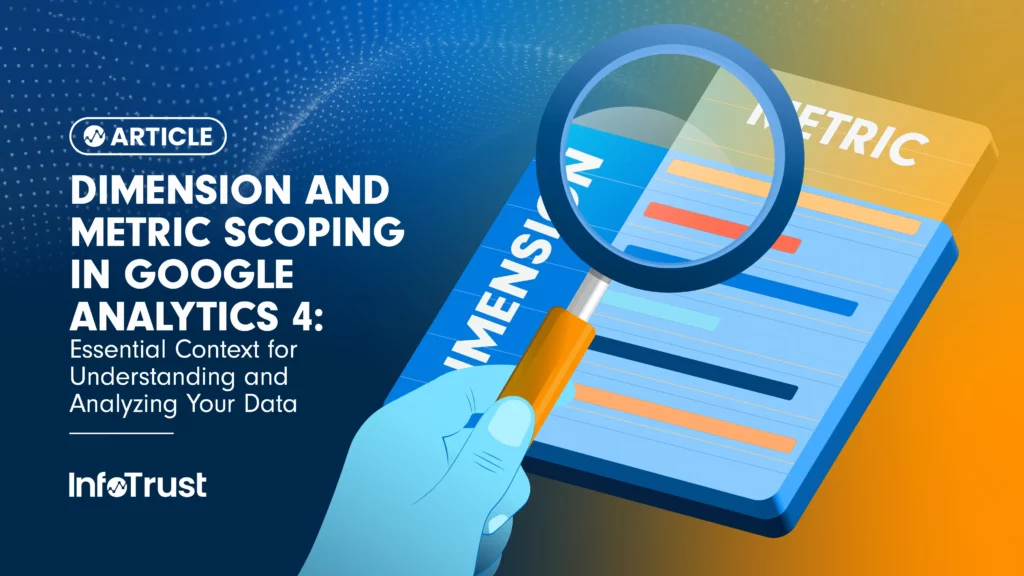As the analytics world has transitioned from the supremacy of Universal Analytics into the new era of Google Analytics 4 (GA4), it has become apparent that there are some common blockers to fully activating GA4’s functionality. GA4’s event-based data model is more flexible and capable of meeting diverse business measurement use cases and aligns with industry standards, but does require a reexamination of how we gather and classify data. At the heart of this change in data model is the concept of scoping, the details of which are absolutely crucial to understand in order to enable accurate and meaningful reporting in GA4. Understanding the scopes of dimensions and metrics in GA4 will save you time and headaches when analyzing your data.
Let’s quickly level-set some definitions, so that we can better understand all the moving parts of this topic.
In GA4:
- An event represents an interaction or occurrence on your website or app.
- A dimension is an attribute that describes something about your data.
- A metric is a quantitative measurement of your data.
For example, a common scenario:
A user purchases an item from your website. This causes an event to be collected in your GA4 property. The event name, which is a dimension, could be “purchase”. In the GA4 user interface, you could look at a metric, “Purchases,” which is the count of purchase events.
This is where scoping comes in. GA4 has flexibility with respect to which entities your dimensions and metrics can describe. In the above example, you may want to collect data about:
- The purchase event itself (e.g. the currency used)
- The user who completed the purchase (e.g. a customer ID)
- The items that were purchased (e.g. the brand name)
In this case:
- The currency would be an event-scoped dimension because it is descriptive of the event
- The customer ID would be a user-scoped dimension because it is descriptive of the user
- The brand name would be an item-scoped dimension because it is descriptive of the item
The appropriate use of these scopes when implementing GA4 tracking and analyzing GA4 data is not only crucial to the accuracy of your analysis, but also allows access to the full functionality of GA4’s reporting suite.
Certain standard reports make use of user- and item-scoped dimensions and metrics to allow targeted reporting about the users who visit your site/app and the items you sell.
When you define custom dimensions and metrics to describe and measure interactions on your digital property, you are prompted to choose a scope (event, item, or user). Armed with the above information, you can decide what that dimension or metric describes, and choose the appropriate scope.
But wait! There’s more.
Sessions in GA4 are defined as a group of interactions by a single user that occur within a specific time frame. Sessions can be a useful framework to apply to a set of interactions, in the service of understanding users’ habits and patterns. Some of GA4’s built-in dimensions and metrics are session-scoped, i.e. context about- and/or measurement of information about the session. Take, for example, “landing page.” As a dimension, the landing page is the name of the first page a user views in a given session. This is information about the session, and therefore the landing page is a session-scoped dimension.
Attribution Scope Confusion
One of the most important questions businesses seek to answer with GA4 is “Where is my traffic coming from?” This question is more complicated than it seems, which is why GA4 was built to address it from multiple perspectives. This complexity and GA4’s chosen naming convention have introduced some confusion around these critical dimensions.
Since GA4 is built on an event-based data model, it processes every event to detect any new campaign or touchpoint information. From that data, it calculates and populates attribution dimensions for the following scopes:
- User-scoped (e.g. First user source / medium represents the first touchpoint that brought a user to your digital property) – All user-scoped attribution dimensions will be appended with “First user.”
- Session-scoped (e.g. Session source / medium represents the touchpoint that brought a user to your digital property to start a given session) – All session-scoped attribution dimensions will be appended with “Session.”
- Event-scoped (e.g. Source / medium, see below for details) – All event-scoped attribution dimensions will not be appended with “First user” or “Session.”
This last scope of attribution information may seem complex at first, but please bear with me. Imagine, if you will, an event-scoped Source / medium, which keeps track of the last touchpoint before any given event. This is essentially what GA4’s Source / medium is, except it is only available for events that you have toggled on as key events.
Important: By Google’s definition, a key event is an event captured by GA4 which “measures an action that’s particularly important to the success of your business.”
This limitation may seem confusing at first, but it is intended to help you narrow your focus to understanding the touchpoints that lead to important events on your site. To fully understand how Source / medium and other key-event-scoped (my own terminology, which I hope eliminates ambiguity) dimensions, you must know that they are populated via the attribution model you have selected in the Admin section of your GA4 property. The “Last click” model would show only the last touchpoint that occurred before the key event. The “Data-driven” model would give fractional credit (based on Google’s proprietary algorithm) to all the touchpoints that led up to the key event. Read more on Google’s traffic-source dimension scopes.
Now you are up to speed on what scopes are, why they’re important, and what you can expect to see in GA4. This knowledge will keep you from falling victim to the confusion of “mixing scopes” and the misleading reporting that can result. GA4’s flexibility can be a great asset to the thoughtful analyst/marketer, but it can also befuddle and hamstring those who underestimate the importance of scoping.


